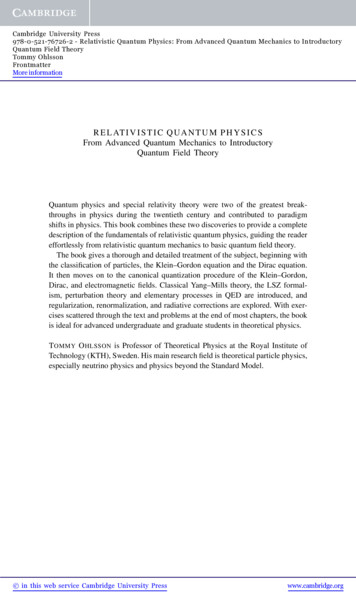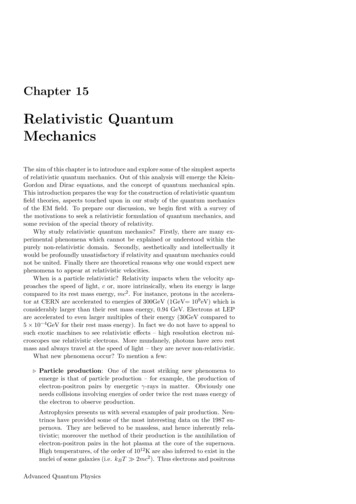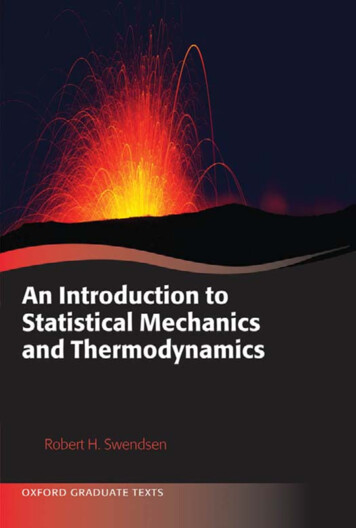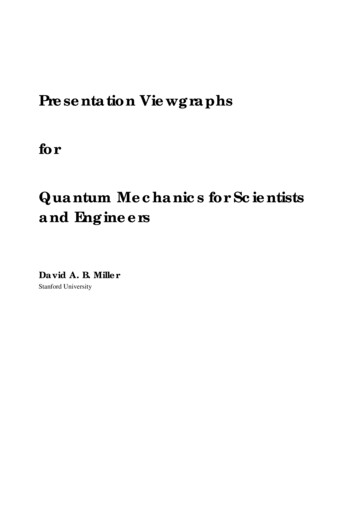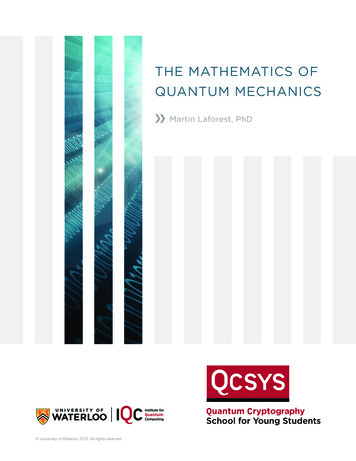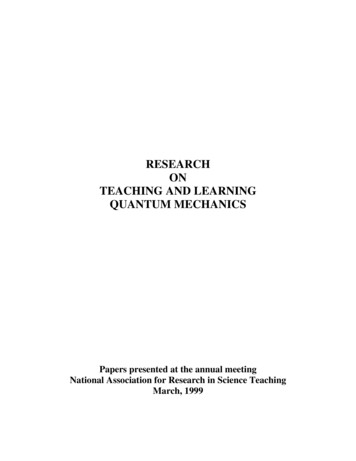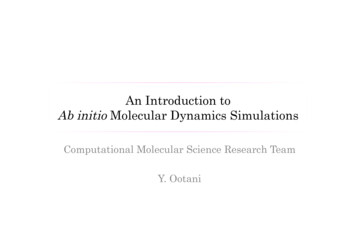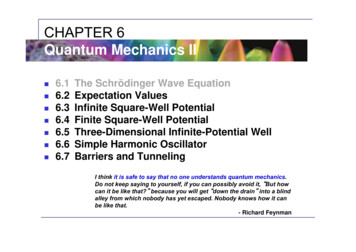
Transcription
CHAPTER 6Quantum Mechanics II 6.16.26.36.46.56.66.7The Schrödinger Wave EquationExpectation ValuesInfinite Square-Well PotentialFinite Square-Well PotentialThree-Dimensional Infinite-Potential WellSimple Harmonic OscillatorBarriers and TunnelingI think it is safe to say that no one understands quantum mechanics.Do not keep saying to yourself, if you can possibly avoid it, “But howcan it be like that?” because you will get “down the drain” into a blindalley from which nobody has yet escaped. Nobody knows how it canbe like that.- Richard Feynman
6.2: Expectation Values Useful to relate the wavefunction to measurable quantities.In quantum mechanics the expectation value is: the expected result of the average of many measurements of a given quantity.The expectation value of x is denoted by x .Conversely, for a single measurement the expectation value predicts the mostprobable outcome.Any measurable quantity for which we can calculate the expectationvalue is called a physical observable.The expectation values of physical observables (for example,position, linear momentum, angular momentum, and energy) must bereal, because the experimental results of measurements are real.Example: The average value of x (statistics) is
Continuous Expectation Values We can change from discrete tocontinuous variables by using theprobability P(x,t) of observing theparticle at a particular x. In quantum mechanics, the probabilityis P(x) 2 by using the wavefunction and the expectation value is: If the wave function is properlynormalized, the expectation valuebecomes: The expectation value of any functiong(x) for a normalized wave function:
ExamplesA a particle is described by the wave function Ψ(x) ax between x 0 and x 1,and zero elsewhere. Find a: Find the probability of finding the particle between x1 0.45 and x2 0.55. Find x
Momentum Operator Suppose we want to find the expectation value for the momentum, p. But what do we insert for p? we need a “momentum extractor” that represents p in such a way that we canevaluate p .given the variable of integration is x, this “extractor” should be expressed interms of x.If we start with the wave function for a free particle, this wave functioncan also be written as:
Momentum Operator: So how do we extract p from the wave function? If we take the derivative of the wave function of the free particle with respect to x: Rearranging: The quantity on the right has “extracted” the momentum of the wavefunction. This extractor is defined to be the momentum operator: Using the operator the expectation value for the momentum is
Energy Operator: Energy operator is able to extract the energy of the particle.The time derivative of the free-particle wave function isSubstituting ω E / ħ yields Therefore we can also define the energy operator: The expectation value of the energy is
Operators We developed expressions for the momentum and energy operatorsusing the wave function of the free particle, however the resultsare valid for any wave function.In general, an operator is a mathematical operation that transformsone function into another.Each physical observable has an associated operator that is usedto find that observable's value.Given the form of some operators, the order of operation isimportant. the operator must be placed between Ψ* and Ψ to operate on Ψ.
Schrödinger equation as an operator equation For non-relativistic particle the total energy is the sum of the kineticand potential energies: Writing the equation in terms of operators and letting both sides ofthe equation operate on the wave function: Therefore the Schrödinger equation can be considered anoperator equation for the total energy.
6.3: Infinite Square-Well Potential Will now apply the formalism developed to several potentials.In each case we will: Determine the wave function and associated observables.will see that some observables are quantized.The simplest example is that of a particle trapped in a box withinfinitely hard walls that the particle cannot penetrate. Thispotential is called an infinite square well and is given by: We have looked at this situation previously(particle confinement in section 5.6, particle ina box in section 5.8), however we now revisitthe problem using Schrödinger wave mechanics.Clearly the particle is restricted to reside in theregion where the potential is zero(the wave function must be zero outside).
6.3: Infinite Square-Well Potential Where the potential is zero inside the box, the Schrödinger waveequation becomeswhere. The general solution is Boundary conditions dictate that the wave function must be zeroat x 0 and x L. to ensure ψ 0 at x 0 B 0.to ensure ψ 0 at x L k nπ/L (where n 1,2,3,.).The wave function is now:
Quantization We normalize the wave function: The normalized wave function becomes These functions are identical to those obtainedin classical physics for a vibrating string with fixed ends.
Quantized Energy The quantized wave number now becomes Solving for the energy yields Note that the energy depends on the integer values of n. Hence the energy is quantized and nonzero.The special case of n 1 is called the ground state energy Classically probability isuniform P(x) 1/LFor large n classical and quantumresults should agree.
Example 6.8 Determine expectation value for p and p2 of a particle in an infinitesquare well in the first excited state. The first excited state corresponds to n 2 therefore: The answer means particle is moving left as often as right. For p2 : Comparing with E2:
6.4: Finite Square-Well Potential
Finite Square-Well Solution
Finite Square-Well Solution
Other differences Wavelength is somewhat larger for finite wellbecause the wave function extends beyond the well. This leads to a smaller momentum (p h/λ) slightly lower energy levels.For a finite well, Number of levels is limited by the potential height, V0. Define the penetration depth x as the distanceoutside the potential well where the probabilitysignificantly decreases:finite wellInfinite well penetration depth deeper as E approaches V0. It should not be surprising to find that the penetration distancethat violates classical physics is proportional to Planck’s constant. Actually, detecting particle in classically forbidden region difficult. x δx (small) implying p and thus K ћ/(2m(δx)2) (large) no experiment could be certain the particle has negative K.
6.5: Three-Dimensional Infinite-Potential Well In 3-d the wave function is a function of all three spatial coordinates, ψ(x,y,z). In 3-d the time independent Schrödinger wave equation takes on the form: Consider a free particle in a 3-d boxof dimensions L1, L2, L3. Find the wave functions and energies.
Particle in 3-d box - Solution Given the fact that the particle is free inside the box the x, y and zdependent parts of the wave function must be independent or: ( x, y, z ) X ( x)Y ( y ) Z ( z ) A reasonable solution ( x, y, z ) A sin(k1 x) sin( k2 y ) sin( k3 z ) Find k1, k2, k3 by applying boundary conditions in x, y, & z.Therefore if particle is constrained in 3-d,3 quantum numbers (n1, n2, n3) are requiredto describe the state.
Particle in 3-d box – Solution (Continued) L n ( x, y, z ) A sin( k1 x) sin( k2 y ) sin( k3 z ); kn nn To obtain the energies plug wave function into the 3-d wave equation. Allowed energies are defined by 3 quantum numbers; n1, n2, n3.Ground state corresponds to n1 n2 n3 1. If L1 L2 L3 L,En1n2 n3 2 2222n n n23 2 12mL
3-D box (Degeneracy) ( x, y, z ) A sin( k1 x) sin(k2 y ) sin(k3 z )kn nn / Ln En1n2 n3 2 2 2 2 2 2 222 k1 k2 k3 2mL2 n1 n2 n3 2mA quantum state is degenerate when there ismore than one wave function for a given energy. (ex) E211 E121 E112Degeneracy results from particular propertiesof the potential energy function that describes the system. A perturbation of the potential energy can remove the degeneracy.
6.6: Simple Harmonic Oscillators Simple harmonic motion (SHM) can be applied to describe many physicalsituations: springs, diatomic molecules and atomic lattices. The most obvious example is the motion of a spring. During oscillation the total energy E K V is conserved.
Simple Harmonic Oscillators Potentials of many other physical systems can be approximated by SHM.Diatomic molecules In general if we expand any potential in a Taylor expansion about theequilibrium position: Redefining the zero of potential (V0 0), and since dV/dx 0 at equilibrium (V1 0),we may approximate the potential11V ( x) V2 ( x x0 ) 2 V ( x) x 2 ( x0 0)22
Quantum treatment of simple harmonic motion Want to look at the quantum treatment of simple harmonic motion (SHM).The time independent form of the wave equation is:1V ( x) x 22 The solutions are wave functions of the following form: n ( x ) H n ( x )e x 2 /2Hn(x) are Hermite polynomials of order n (n 0, 1, 2, 3,.).
Quantum treatment of simple harmonic motion n ( x ) H n ( x )e n ( x) x 2 /22 3 ( x) 2 ( x) 1 ( x) Contrary to the classical case in groundstate the largest probability at the center. Classically, the probability of finding theparticle is greatest at the ends of motion andsmallest at the center (see dotted line at n 10) this because particle slows down andspends more time at the turning points in agreement with Bohr’s correspondenceprinciple for large n quantum and classicalpredictions merge. 0 ( x)classicalprobability 10 ( x )2
SHM: Classical results In the classical case the particle oscillates back and forth,the total energy of the system remains constant. E0 K V conserved At the equilibrium position all energy is kinetic.At the turning points ( a) all energy is potential i.e. velocity is zero,and a amplitude of oscillation.
SHM: Quantum results 0 ( x) As was the case for the potential well, the allowed energies are quantized and given by:En n 12 n 12 mNow n 0 is allowed, E 0 is not allowed since it would violate the uncertainty principle.Zero energy would mean x and K (p) simultaneously zero.1The zero point energy (E0) is called the Heisenberg limit E0 2 E or spacing between levels is constant E ½ħω.Wave function is non-zero beyond the classical turning points where it decaysexponentially.
Example Find expectation value for x2 for the ground state of the harmonic oscillator.
6.7: Barriers and Tunneling Consider a particle of energy E approaching a potential barrier of height V0and the potential everywhere else is zero.Let’s consider two cases: E V0 and E V0Case I: E V0incidentCase II: E Classical: Reflection 0Quantum: Reflection 0(Barrier)Classical: Transmission 0Quantum: Transmission 0(Tunneling)
Case I: E V0 (Barriers) Classically the particle would pass the barrier, however in region II the kinetic energy wouldreduced by a factor V0 (energy, E conserved) Because of wavelike properties, quantummechanics predicts different behavior. When waves are incident on a boundarybetween two media a portion of the wave istransmitted and a portion can be reflected. In regions I and III the wave numbers are: In the barrier region II we have
Reflection and Transmission (when E V0) The wave functions can be determined by solving the Schrödinger equation andapplying boundary conditions. Potentials and Schrödinger wave equations are: The corresponding solutions are: e iki x(propagate to x direction)e iki x(propagate to -x direction)As the incident wave moves from left to right,AeikI xBe ikI x(G 0)FeikI x
Probability of Reflection and Transmission The reflection probability R and transmission probability T are: Because the particles must be either reflected or transmitted, R T 1By applying the boundary conditions at x 0, L: we arrive at the transmission probability Notice that T 1 only when: i) V0 0, or ii) kIIL nπ.
Case II: E V0 (Tunneling) Now we consider the situation where classically the particle does not haveenough energy to surmount the potential barrier, E V0.Classically expect total reflection(K in the barrier would be negative) ik II The quantum mechanical result, however, is one of the most remarkablefeatures of modern physics, and there is ample experimental proof of itsexistence. There is a small, but finite, probability that the particle can penetratethe barrier and even emerge on the other side.The wave function in region II becomes: II ( x) Ceik x De ik x Ce x De x ; II IIThe transmission probability thatdescribes the phenomenon of tunneling is2m(V0 E ) k II 2m( E V0 )
Uncertainty Explanation of Tunneling (Case II: E V0) So quantum result is that there is a non-zero probability the particle can penetrate the barrier and emerge on the other side the incident particle can tunnel the barrier. II Ce x De xExponential decayincidentTunnelingtransmittedreflectedI I Aeik x Be ik xI III Feik xIConsider when κL 1 then the transmission probability becomes:kL sinh(kL) 12 e kL The particle is allowed in the barrier region by quantum mechanics and theuncertainty principle lets it penetrate into a classically forbidden region. The minimum such kinetic energy is: This violation allowed by the uncertainty principle is equal to the negativekinetic energy required!
Example 6.14 L 0.8 nm, E 5 eV , V0 10 VIn a particular semiconducting device, electrons thatare accelerated through a potential difference of 5 Vattempt to tunnel through a barrier of width 0.8 nmand height 10 V. What fraction of electrons areable to tunnel through the barrier?Approximately
Example 6.16L a) Find the penetration distance (penetration depth)(distance where the probability drops by 1/e). b) Calculate the depth for a 5 eV electron approaching a step barrier of 10 eV. I ( x) Aeikx Be ikx ; k II ( x) Ce x De x ; 2mK 2m(V0 E ) Boundary condition for x : C 0 II ( x) De xl Penetration distance l :( E K 5 eV , V0 10 V )l hc4 2mc (V0 E )212 0.044 nm
Analogy of tunneling with Wave Optics If light passing through a glass prism reflects from aninternal surface with an angle greater than the criticalangle, total internal reflection occurs. However, the electromagnetic field is not exactly zerojust outside the prism. If we bring another prism veryclose to the first one, experiments show that theelectromagnetic wave (light) appears in the secondprism. The situation is analogous to the tunneling describedhere. This effect was observed by Newton and can bedemonstrated with two prisms and a laser. The intensity of the second light beam decreasesexponentially as the distance between the two prismsincreases.LT e 2 L
Alpha-Particle Decay The phenomenon of tunneling explains the alpha-particle decay of heavy,radioactive nuclei. Inside the nucleus, an alpha particle feels the strong, short-range attractivenuclear force as well as the repulsive Coulomb force.The nuclear force dominates inside the nuclear radius where the potential isapproximately a square well.The Coulomb force dominatesoutside the nuclear radius.The potential barrier at the nuclearradius is several times greater thanthe energy of an alpha particle.According to quantum mechanics,however, the alpha particle can“tunnel” through the barrier.Hence this is observed as radioactive decay.
Scanning Tunneling Microscopy (STM)
Direct Measurement of IψI2 using STM
6.2: Expectation Values Useful to relate the wavefunction to measurable quantities. In quantum mechanics the expectation value is: the expected result of the average of many measurements of a given quantity. The expectation value of x is denoted by x . Conversely, for a single measurement the expectation value predicts the most probable outcome.
